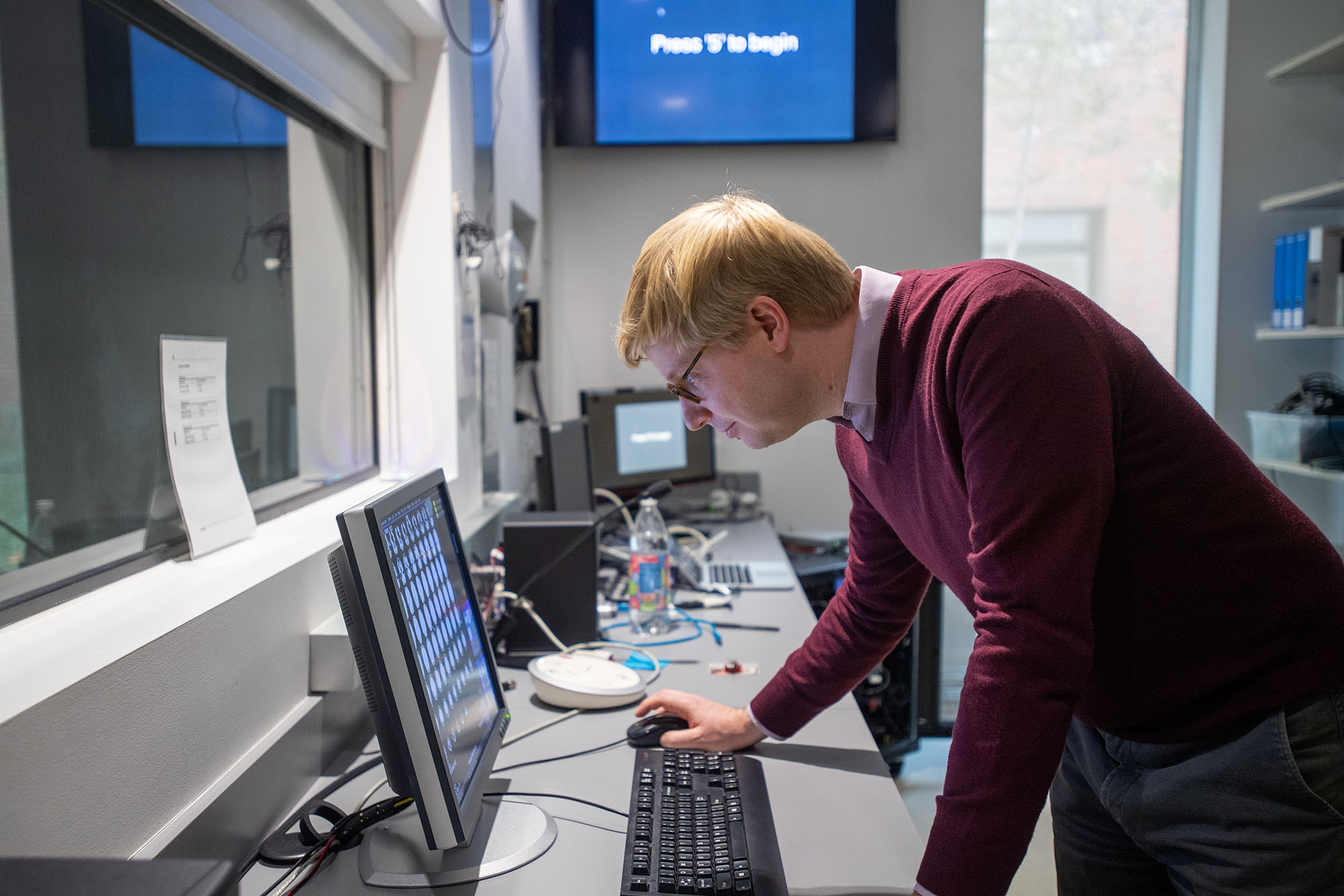Neurobiology Class Gets a Peek Inside a Volunteer’s Brain
Neurobiology of Language students investigate a particular question about the brain and language, using BU’s fMRI scanner

Stephanie McMains (GRS’06), associate director of the Cognitive Neuroimaging Center (seated), explaining to Arielle Moore (CAMED’26) how the fMRI scanner produces an image of a brain in the Cognitive Neuroimaging Center in CILSE.
Neurobiology Class Gets a Peek Inside a Volunteer’s Brain
Neurobiology of Language students investigate a particular question about the brain and language, using BU’s fMRI scanner
As Paris Gappmayr prepared to enter the giant magnetic tube, she first had to ditch her glasses. The metal frames would throw off the imaging results. Instead, she was outfitted with a pair of armless goggles with interchangeable lenses that were a close enough approximation of her prescription. They would sit on her face while she lay prone in the machine as students examined her brain activity.
Gappmayr (Sargent’25), a Boston University doctoral candidate, was volunteering as a human subject for a series of experiments designed by her undergraduate counterparts in the Neurobiology of Language course, taught by Tyler Perrachione, a Sargent College of Health & Rehabilitation Sciences associate professor, using a functional magnetic resonance imaging (fMRI) machine. The machine measures brain activity by detecting changes associated with blood flow. In this way, students could see which parts of Gappmayr’s brain were activated, and when, during certain experimental tasks.
The 16 students in the class broke into five groups to investigate a particular question about the brain and language, Perrachione explains. One group studied how Gappmayr’s brain responded to words that were spelled properly versus words that were scrambled or made up altogether. Another group examined how her brain processed speech and American Sign Language (Gappmayr is fluent in both English and ASL).
“This is a really exciting opportunity for our students,” Perrachione says as he calibrates the fMRI scanner housed in the Kilachand Center for Integrated Life Sciences & Engineering (CILSE). “This sort of hands-on research is a unique experience for our undergrads.”
Once the scanner was up and running, Gappmayr stood for a quick scan with a metal detector, and passed (her permanent retainer—a strip of wire glued to the back of her bottom teeth—notwithstanding). She entered the glass-walled room that holds the fMRI scanner and slid into it, settling in among the foam blocks designed to keep her head perfectly still during the two-hour window students would run their experiments. A computer screen visible to Gappmayr would flash with instructions or give her words to read or say aloud, while the giant humming machine beamed black-and-white cross-section images of her brain to more computer screens outside the glass-enclosed room.

Students in the Neurobiology of Language course filed in and out of the small imaging room as their experiments got underway. Almost everyone uttered a low “Wow” when they saw the images of Gappmayr’s brain in action flash onto the screens before them.
“It was just a really cool experience,” says Adanna Thomas (CAS’23). She and her classmates designed an experiment to study how the brain’s reading network—the areas of the brain that are active when someone is reading—responds to words that were spelled correctly or scrambled. They also examined how these same areas of the brain responded to made-up words.
“We found a lot of evidence that supported our hypotheses,” Thomas says. “We saw a lot of activation in areas we’d expected, and saw that nonwords and irregularly spelled words activated the same areas of the brain.”
But then there was an unexpected finding: the nonwords (words that looked like real words but were actually made up by Thomas and the other members of her group) also activated a part of the temporal cortex associated with semantics. Gappmayr’s brain was searching for meaning in the made-up words.
“Our best guess is that the nonwords looked too similar to real words. We heard from the human subject that she assumed they were just real words she didn’t know,” instead of completely made-up words, Thomas says.
The experience—both the successes and the surprises—taught her valuable lessons, she says. She discovered how important it is to communicate clearly with the other members of her group when they were designing the experiment, and learned how to think through that design process, as well.
“It required a lot of abstract and higher-order thinking, more than I expected,” Thomas says.
The experience also helped clarify her goals for after graduation. While she knew she wanted to do research in a lab setting, actually running her own experiment has made her think differently about what sort of experimentation she’s interested in.
“It helped me fine-tune my thought process,” she says.
Comments & Discussion
Boston University moderates comments to facilitate an informed, substantive, civil conversation. Abusive, profane, self-promotional, misleading, incoherent or off-topic comments will be rejected. Moderators are staffed during regular business hours (EST) and can only accept comments written in English. Statistics or facts must include a citation or a link to the citation.